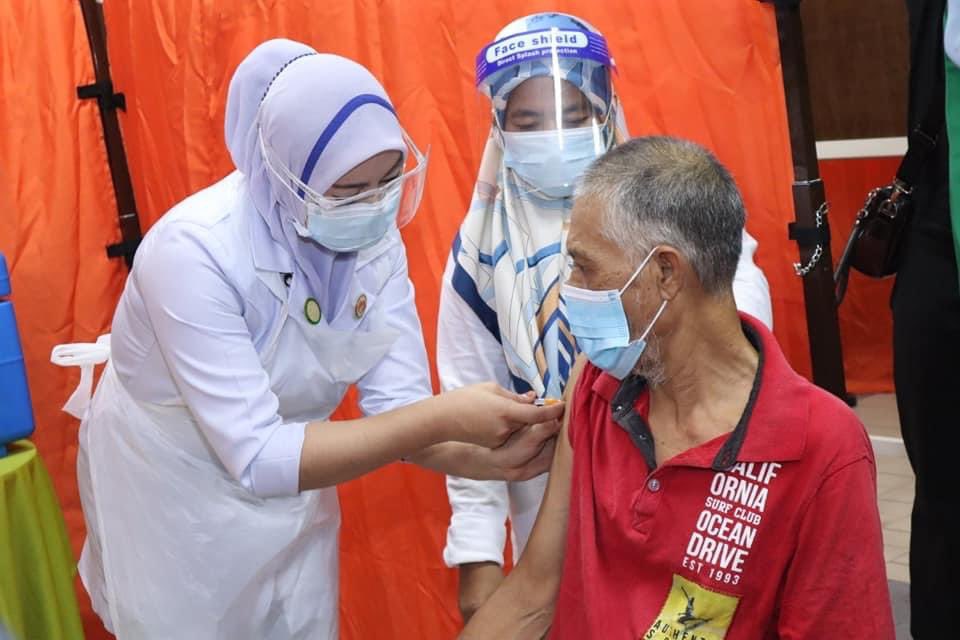KUALA LUMPUR, June 11 — Higher Covid-19 vaccination rates appear to be closely associated with lower coronavirus-related fatalities in Malaysia, indicating that vaccines are able to reduce severe disease and death from the virus.
Our team — comprising epidemiologists who can only write anonymously due to the government’s gag order on civil servants — ran an analysis comparing Covid-19 vaccination rates and the Covid-19 Case Fatality Rate (CFR) from May 1 to June 4 this year on a national basis and selected states: Perak, Selangor, Negeri Sembilan, and Kelantan.
Since it takes 14 days for immunity to kick in after getting a jab, our analysis is adjusted accordingly — meaning those who were vaccinated on May 1 will be reflected on May 14.
Case fatality rate is defined as the number of people passing away from Covid-19 divided by the number of detected cases of Covid-19. In this article, it is calculated on a day-to-day basis and then averaged out over a seven-day period. A CFR of 1.0 indicates 1.0 per cent or one mortality among 100 patients with Covid-19. A seven-day CFR average of 1.0 indicates 1.0 per cent or one death amongst 100 Covid-19 patients over a seven-day period.
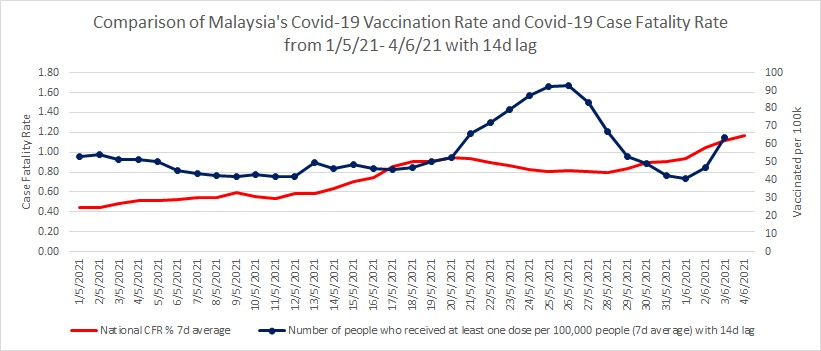
We can see that every time there is a dip in the Covid-19 vaccination rate in Malaysia (seven-day average of the number of people who received at least one dose per 100,000 people with a 14-day lag), we see an increase in both average Covid-19 deaths and the case fatality rate (CFR).
Interestingly, despite a subsequent ramp-up of vaccination, the average baseline of deaths (though constant) keeps finding a new higher baseline.
The Covid-19 vaccination rate per 100,000 people with the lag hovered about 40 to 50 per day until May 20, subsequently rising from 70 to 90 people vaccinated per 100,000 people from May 21 to 25. During that period, the CFR plateaued at 0.8 per cent, but with the decrease of vaccination over subsequent days, we saw a gradual increase again in the CFR. However, we must remember that there is currently unequal distribution and uptake of vaccines nationally.
In view of this, we have to focus on states to see if this trend is indeed true or false.
We analysed states based on the population size and their CFR:
- Perak (a state that is said to have a good vaccine rollout)
- Selangor (a state that wants vaccines but can’t obtain them yet)
- Negeri Sembilan (a state that has been seeing a CFR increase)
- Kelantan (a state with vaccine hesitancy)
Perak
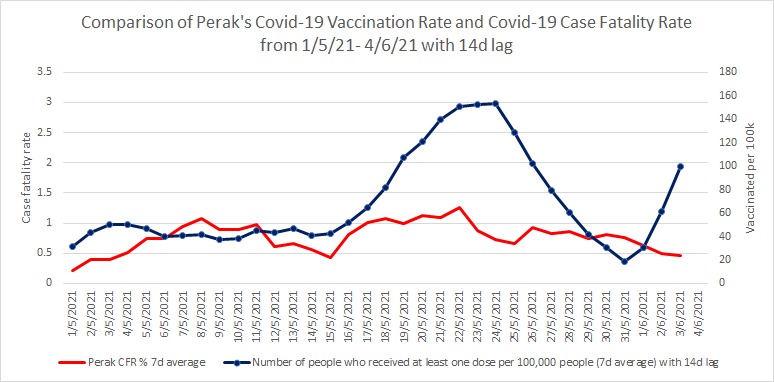
We have read that Perak has been doing a fantastic job in the Covid-19 vaccine roll-out.
A drop in Perak’s Covid-19 vaccination rates in early May saw a daily spike in the CFR and an increase in the seven-day CFR average. When Covid-19 vaccination ramped up, the state’s seven-day CFR average subsequently declined.
For example, from May 1 to 4, the rate of daily Covid-19 vaccinations was good (30 to 50 vaccinated people per 100,000). But with a decline in vaccination numbers over the next four days from 50 to 30 vaccinated people per 100,000, we saw the CFR rise from 0.7 to about 1.0.
Again, from May 15 to 23, there was a ramp-up in vaccinations (40 to 150 vaccinated people per 100,000). During that period, the CFR remained fairly constant at between 1 and 1.25, although nationally, the CFR at that time saw a rise.
The CFR stabilised amid a decline of Covid-19 vaccination rates since May 24 to 20 vaccinated people per 100,000, although there were some spikes in the CFR, especially on May 26, 28 and 30.
However, a word of caution here: we have seen in the past that every time there is a surge of vaccinations and a subsequent fall in the numbers, we find that mortality rates increase and then hover over a slightly higher new baseline. This shows that irregular vaccinations might lead to an increase in the CFR, no matter how much it is ramped up.
This is what we intend to see in Malaysia as we progress rapidly with our Covid-19 vaccination programme.
A total of 18.96 per cent of the registered population in Perak have been vaccinated with at least one dose as of June 4, while 35.32 per cent of the total population have registered to be vaccinated.
Thus, the lesson learnt here is that a ramp-up of Covid-19 vaccination can reduce the CFR, but if the inoculation pace is erratic, we will see a shift in the baseline of deaths from the coronavirus. This is perhaps due to rampant spread of the virus during low vaccination days, especially among the population that has yet to be vaccinated.
We need to ramp up testing in areas and keep them constant so that the baseline CFR doesn’t move up and claim more lives. This is what we want to finally achieve in the country — a good supply of vaccines helping with vaccine uptake and good rates of vaccination for wholesome control of the epidemic.
Selangor
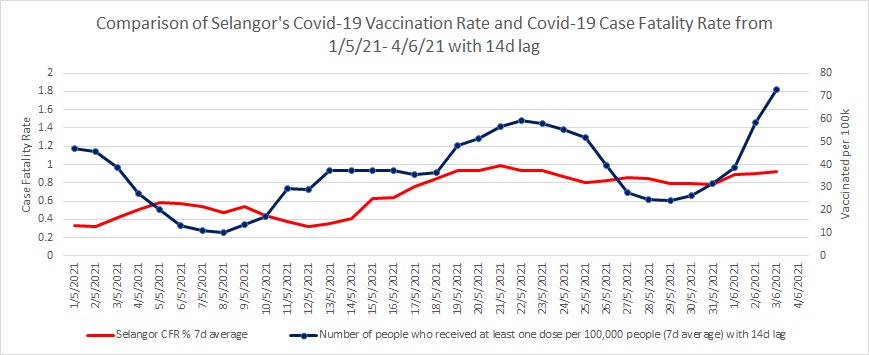
Only 9.04 per cent of the Selangor population registered for vaccination have received their shots as of June 4, although 50.8 per cent of their total population are willing to be vaccinated.
We can see that when there is a dip in the number of people vaccinated daily, the CFR and seven-day average reacts spontaneously towards the number of vaccinations. This is because the state of Selangor is highly dense and well populated.
Any form of reduction in vaccination, especially on a day-to-day basis, will result in a high statistical reaction towards the death total. For example, notice that May 1 started with a good rate of vaccination (about 50 vaccinated people per 100,000).
As time progressed till May 5, Covid-19 vaccination declined to 20 vaccinated people per 100,000. The CFR immediately responded towards that dip and doubled from 0.3 to 0.6 in that time.
Even a slight plateauing of daily vaccination numbers – 35 to 37 vaccinated people per 100,000 from May 13 to 18 – the average CFR rose. Despite a sudden surge in Covid-19 vaccination from 50 to 60 vaccinated people per 100,000 from May 19 to 24, and a subsequent rise to 75 vaccinated people per 100,000 from May 31, we see that that the seven-day CFR remains at the same rate (between 0.8 and 1.0 over the specified time).
This shows that the only way we can keep the CFR low and constant with a hope of a decline is to retain vaccination at a consistently high rate.
This state shows us many things. With a great number of health care facilities in Selangor and rampant testing, much can be done, but it will still need the support of vaccination to suppress the number of Covid-19 deaths.
We need a constant supply of vaccines, especially in highly dense areas, as spread of the coronavirus can be rampant in these places and vaccinations given erratically might take time to reduce Covid-19 deaths, especially the CFR baseline.
There is a supply and demand issue here as though there are many people willing to be vaccinated in Selangor, the vaccine rollout has been limited.
This will eventually cause a problem in trying to achieve herd immunity, especially since the population density of the state is high. This has to be urgently addressed.
Negeri Sembilan
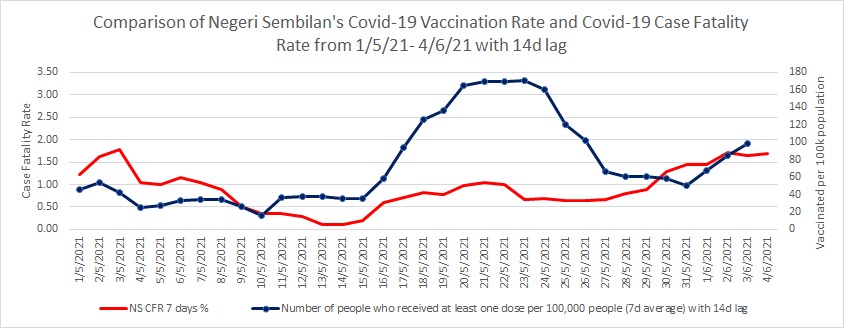
This is a state of concern. We can see that from Day 1, the rollout of vaccines in Negeri Sembilan has been rather poor.
However, as vaccination ramped up over time, cases of Covid-19 fatality plateaued. After the dip towards the end of the month, the rise in CFR was prominent, especially the baseline shift.
For example, we saw a reduction in CFR from May 10 onwards during an increase in the Covid-19 vaccination rate from 20 to 30 vaccinated people per 100,000.
When there was a massive vaccination ramp up from May 16 (30 to 170 vaccinated people per 100,000), we saw the CFR being supressed at between 0.5 and 0.6, with a short interval at 1.0.
However, from the time Covid-19 vaccinations per day were reduced since May 24 (from 160 to 50 vaccinated people per 100,000), we saw that the CFR baseline of 0.7 rose to about 1.5 to 1.75 within a short period of time.
This phenomenon is common in smaller states, especially where residences might be confined to certain areas. Hopefully, with the rise in the number of people vaccinated per day since June 1, we will see a decrease in the CFR for days to come.
A total of 16.19 per cent of the registered population has been vaccinated with at least one dose as of June 4, with 43.43 per cent of their entire population willing to be vaccinated.
Ramping up vaccination in smaller states is just as vital as in other bigger states. This is because Covid-19 spread can be fast in smaller states due to the limited areas designated for residence (residences might be highly dense in certain areas due to geographical reasons, i.e. other regions covered with forest/water etc).
With the ramping up of vaccination, we see that Covid-19 fatality rates can be controlled. However, erratic delivery of vaccines might not assist with the situation, especially in smaller states.
Kelantan

From the graph, we can see that the decline in Covid-19 vaccination rates will see a gradual increase in the CFR. From May 1, with a drop in daily vaccination rates from 55 to about 30 vaccinated people per 100,000, we see that the CFR moved from 0.4 to nearly 1.0, nearly a 2.5-fold increase.
But what is strange here in Kelantan is that although towards the end there was a pick-up in vaccinations from May 31 from 25 to 78 vaccinated people per 100,000, the CFR baseline seemed to be shifting upwards (from 0.3 to nearly 1.0).
This could be due to the fact that there was very low uptake of vaccinations in the state. A total of 23.63 per cent of those registered have been vaccinated with at least one dose as of June 4, but only 23.49 per cent of their entire population have registered for jabs.
This goes to show that though we may be ramping up vaccinations, but if there is inadequate uptake, we might still end up with many people dying from Covid-19 as we cannot achieve the intended herd immunity.
It is pointless having much vaccine supply within the state if there is very poor uptake — the result will be similar to not having vaccines. We learn here that if shots are not injected into arms despite vaccine availability, the situation remains status quo.
Covid-19 vaccines must then be redeployed to areas that are willing to uptake the vaccines so that herd immunity can be achieved faster in these vaccine acceptance areas.
Though it sounds selfish, it is the only way to ensure that areas willing to use the vaccines should be given an equal fighting chance to exit the epidemic as soon as possible.
Conclusion
The situation and exit from this pandemic and MCO rely heavily on how fast we can mass vaccinate the community. From the plotting of the above graphs according to states with different predicaments, we see that vaccination is a potentially successful way out, but it has to be done carefully, with great caution and at a constant but high pace.
One of the ways to mitigate vaccine administration is to provide vaccines to areas with a high number of vaccine registrations first, followed by areas with lower registrations (since our system is opt-in instead of an opt-out). This will reduce logistics and reduce wastage from transporting vaccines to other areas with poor uptake.
The idea is to focus on areas that want the vaccines as soon as possible. This includes areas in our workforce like factories and other areas of high spread. One of the brilliant concepts we have heard is to mass test during this MCO 3.0 and to administer vaccines if the person tests negative for Covid-19. We achieve ring immunity faster that way and we end up opening up from the MCO to a safer community.
Until we achieve good immunity within our community, our testing and active case detection must not stop. These are the ways out for Malaysia. We must consider this fact – if you are having a business, where would you open your business? In a place with many potential customers, or a place you know where there will be fewer customers?
Testing follows the same concept – test more in areas where there are potential outbreaks and when these people test negative, offer them vaccination straight away. This will help prevent future outbreaks in that area.
Though deemed a silver bullet, we must realise that we must continue to practice all preventive measures so that we avoid another pandemic in the near future. The success of this mitigation is having vaccines in hand and administering it as soon as possible.
We must remember that Covid-19 is going to be like the flu. At the moment, Covid-19 is taking many lives. We foresee it to take up a few lives in future after herd immunity is achieved.
We accept that deaths will happen with Covid-19, but the numbers will reduce and it will be like the common cold one day. Until then, we have to be vigilant and ensure that we play our part in opting to get the vaccine.
With this analysis, the researchers sincerely believe that vaccination rates can serve as a good predictive analysis for what is to come in the near future, especially towards the mitigation of Covid-19.
As we know that immunity kicks in within two weeks, we can prepare our health care facilities should vaccination rates drop before herd immunity is achieved (due to some reason or another), so that the health care system can brace itself by beefing up resources, especially where ICU beds and ventilators are concerned.
Edited by Boo Su-Lyn.


